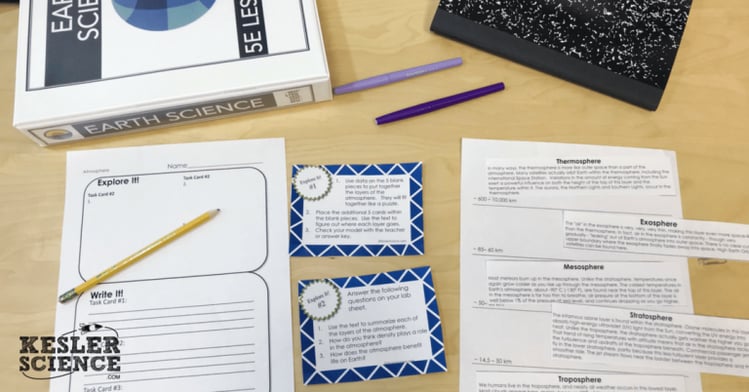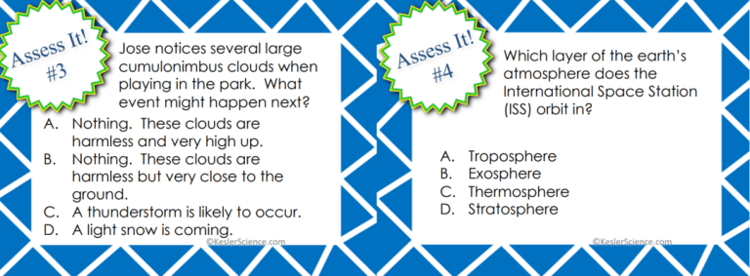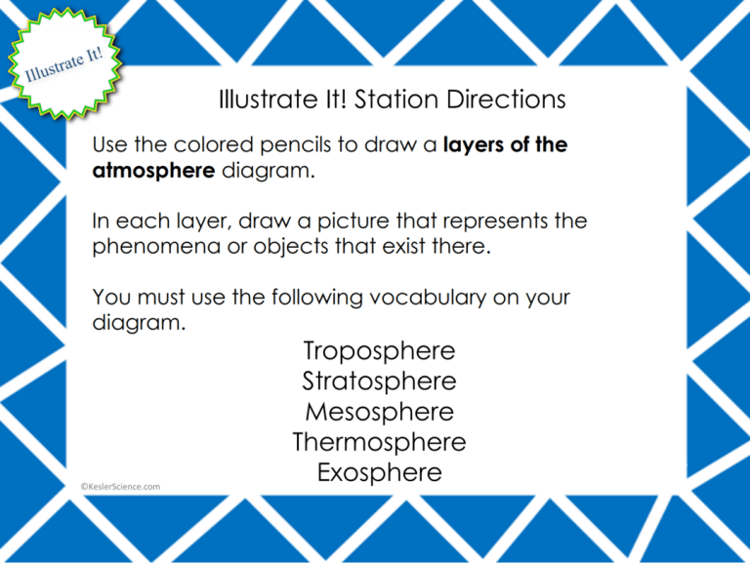
The teacher will help to clear any misconceptions about the atmosphere. A major misconception is that students may think that air has no weight, and also believe that air is not the same everywhere, but we as teachers must explain that air is just a combination of a set of gases.
Estimated Class Time for the Engagement: 20-30 minutes
EXPLORATION
This student-centered station lab is set up so students can begin to explore the atmosphere. Four of the stations are considered input stations where students are learning new information about the atmosphere and four of the stations are output stations where students will be demonstrating their mastery of the input stations. Each of the stations is differentiated to challenge students using a different learning style. You can read more about how I set up the station labs here.
EXPLORE IT!
Students will be working in pairs to better understand the atmosphere. In this station, students try to identify the layers of Earth's atmosphere. Students will follow the steps and record their observations on their lab sheet.

WATCH IT!
At this station, students will be watching a short video explaining the atmosphere. Students will then answer questions related to the video and record their answers on their lab station sheet. For example: What are some characteristics of the troposphere? What layer of the atmosphere do many commercial airlines fly in? Why? Describe the ionosphere. Where is it? What is unique about it?
RESEARCH IT!
The research station will allow students to explore interactive web pages that will help them to understand clouds and the atmosphere. Students will be instructed to complete a few tasks and record answers on their lab sheets.
READ IT!
This station will provide students with a one page reading about atmospheric composition. There are 4 follow-up questions that the students will answer to show reading comprehension of the subject.
ASSESS IT!
The assess it station is where students will go to prove mastery over the concepts they learned in the lab. The questions are set up in a standardized format with multiple choice answers. Some questions include: Which is the most abundant element in earth's atmosphere? Which statement is not true? What event might happen next? Which layer of the earth's atmosphere does the International Space Station orbit in?

WRITE IT!
Students who can answer open-ended questions about the lab truly understand the concepts that are being taught. At this station, the students will be answering three task cards: Compare and contrast the troposphere and the thermosphere. What are some of the differences between cumulus and stratus clouds? Describe the chemical composition of the Earth's atmosphere? Which elements are abundant? Which are not?
ILLUSTRATE IT!
Your visual students will love this station. Students are to draw pictures that demonstrate their knowledge of the atmosphere (troposphere, stratosphere, mesosphere, thermosphere, and exosphere).

ORGANIZE IT!
Students at this station will match the sets of cards. Cards are clouds and descriptions, and the students will determine which would be a match. Once students have completed their organization, the teacher will check their understanding.
Estimated Class Time for the Exploration: 1-2, 45 minute class periods
EXPLANATION
The explanation activities will become much more engaging for the class once they have completed the exploration station lab. During the explanation piece, the teacher will be clearing up any misconceptions about atmosphere with an interactive PowerPoint, anchor charts, and notes. The atmosphere lesson includes a PowerPoint with activities scattered throughout to keep the students engaged.
The students will also be interacting with their journals while taking notes from the PowerPoint. If you have students that need modified notes, the 5E lessons come equipped to help give every student access to the lesson.
Estimated Class Time for the Exploration: 2-3, 45 minute class periods
ELABORATION
The elaboration section of the 5E method of instruction is intended to give students choice on how they can prove mastery of the concept. When students are given choice the ‘buy-in’ is much greater than when the teacher tells them the project they will have to create. The elaboration project will allow students research the weather in the Troposphere, clouds in the Troposphere, winds in the Troposphere, water vapor in the atmosphere, temperature n the atmosphere, density in the atmosphere, ozone layer, ionosphere, and the Van Allen Belts.Estimated Class Time for the Elaboration: 2-3, 45 minute class periods (can also be used as an at-home project)
EVALUATION
The final piece of the 5E model is to evaluate student comprehension. Included in every 5E lesson is a homework assignment, assessment, and modified assessment. Research has shown that homework needs to be meaningful and applicable to real-world activities in order to be effective. When possible, I like to give open-ended assessments to truly gauge the student’s comprehension.
Estimated Class Time for the Elaboration: 1, 45 minute class period
DOWNLOAD THE FULL LESSON NOW
The full lesson is available for download from the Kesler Science Store. Save yourself a ton of time and grab it now.





